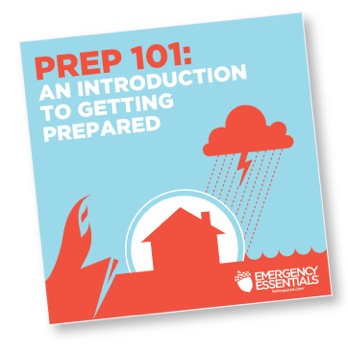 W
hen it comes to rowdy weather, we seem to have it all figured out by region: earthquakes in California, tornadoes in Kansas, hurricanes in Florida, and whiteouts in Maine, right? How, then, do we account for recent phenomena like snow in SoCal, a first-time-ever hurricane off the coast of Brazil, and Oklahoma's new distinction as the US's most earthquake prone state? As we prepare for the unexpected, why is it so hard to know what to expect?
The answer is that Mother Nature refuses to be figured out. She regularly breaks patterns, records, and electrical grids; and her only truly reliable feature is her unpredictability. (Now that I think about it, in some ways she's a lot like my two year-old. Only with a little less applesauce in her hair.)
While meteorologists and seismologists puzzle over the whys and wherefores, for the rest of us, the biggest question regarding the prospect of a natural disaster is something more along the lines of, "How do I not die?"
Good question. For our money, the best way to stay on our toes when Mother Nature is feeling capricious is to prepare for a range of circumstances. Have a fire escape plan and a tsunami evacuation route; know how to secure windows for a hurricane and protect pipes against a freeze; teach kids where to hunker down in an earthquake and where to run to in a tornado.
[caption id="attachment_17641" align="alignright" width="342"]
W
hen it comes to rowdy weather, we seem to have it all figured out by region: earthquakes in California, tornadoes in Kansas, hurricanes in Florida, and whiteouts in Maine, right? How, then, do we account for recent phenomena like snow in SoCal, a first-time-ever hurricane off the coast of Brazil, and Oklahoma's new distinction as the US's most earthquake prone state? As we prepare for the unexpected, why is it so hard to know what to expect?
The answer is that Mother Nature refuses to be figured out. She regularly breaks patterns, records, and electrical grids; and her only truly reliable feature is her unpredictability. (Now that I think about it, in some ways she's a lot like my two year-old. Only with a little less applesauce in her hair.)
While meteorologists and seismologists puzzle over the whys and wherefores, for the rest of us, the biggest question regarding the prospect of a natural disaster is something more along the lines of, "How do I not die?"
Good question. For our money, the best way to stay on our toes when Mother Nature is feeling capricious is to prepare for a range of circumstances. Have a fire escape plan and a tsunami evacuation route; know how to secure windows for a hurricane and protect pipes against a freeze; teach kids where to hunker down in an earthquake and where to run to in a tornado.
[caption id="attachment_17641" align="alignright" width="342"] We all know where “Tornado Alley” is. Or do we? This map shows that tornados occur just about anywhere they choose.[/caption]
Most natural disasters have a specific set of recommended safe practices (check out Ready.gov's disaster specific tips sheets), and we don't want to confuse advice like `stay low in a fire,' and 'stay high in a flood.' Other preparations, however, are not only common to any disaster, but also vital. Here are three that could save your family, no matter what Mother Nature throws your way.
We all know where "Tornado Alley" is. Or do we? This map shows that tornados occur just about anywhere they choose.
Store food. Have we mentioned this before? Once or twice? Whether you're an advanced practitioner, with an extensive and neatly catalogued food storage, or a student with a couple of cans of chili under your bed, you need to consider how to access your stash in a hurry. Most organizations recommend keeping 72 hours worth of food handy. You could pull from your storage and make sure you have enough for each family member for three days in some kind of easily accessible pack. Or you could look into pre-packaged kits, like our Premium 4-Person 72-Hour Food Bucket.
[caption id="attachment_17643" align="alignleft" width="230"]
We all know where “Tornado Alley” is. Or do we? This map shows that tornados occur just about anywhere they choose.[/caption]
Most natural disasters have a specific set of recommended safe practices (check out Ready.gov's disaster specific tips sheets), and we don't want to confuse advice like `stay low in a fire,' and 'stay high in a flood.' Other preparations, however, are not only common to any disaster, but also vital. Here are three that could save your family, no matter what Mother Nature throws your way.
We all know where "Tornado Alley" is. Or do we? This map shows that tornados occur just about anywhere they choose.
Store food. Have we mentioned this before? Once or twice? Whether you're an advanced practitioner, with an extensive and neatly catalogued food storage, or a student with a couple of cans of chili under your bed, you need to consider how to access your stash in a hurry. Most organizations recommend keeping 72 hours worth of food handy. You could pull from your storage and make sure you have enough for each family member for three days in some kind of easily accessible pack. Or you could look into pre-packaged kits, like our Premium 4-Person 72-Hour Food Bucket.
[caption id="attachment_17643" align="alignleft" width="230"] Learn about the 12 Areas of Preparation. Click on this image to download your own online booklet— Prep 1010: An Introduction to Getting Prepared.[/caption]
Learn about the 12 Areas of Preparation. Click on this image to download your own online booklet— Prep 1010: An Introduction to Getting Prepared.[/caption]
Store water. Again, the recommendation is water for three days (though longer term storage is a smart idea!). Figuring one gallon per person per day—and more for pets, children, or the elderly—that adds up quickly. There are loads of water storage options on the market, for long and short term, as well as filters and purifiers in case of contamination. Check here to see our range of water storage barrels, packaged water, and water treatment mechanisms.
Store supplies. You may be MacGyver when it comes to household fix-it jobs, but a collapsed roof or flooded living room are going to require more than duct tape and paper clips. Be sure you have a well-stocked emergency supply kit stashed somewhere you can Replace it readily. FEMA has a useful emergency supply list, for general purposes. For more focused preparation, browse of collection of emergency kits, including everything from auto emergency kits, to power outage kits, to classroom school emergency kits.
So, while this February the Rocky Mountains are enjoying 60° afternoons and Tennessee schools are closed due to icy roads, don’t be outsmarted by that shifty Mother Nature character. The facts are, tornados do strike in Salt Lake City, and Oklahomans will likely feel at least three tremors today. Who knows what’s in store for the rest of the country? Prepare for nature’s curveballs by keeping the basics on hand!

1 comment
Rick Pinney
I have passed this little suggestion along to many places, now to here, I have always had an emergency kit in my car for the winter months as well as the rest fo the year, but one thing that I dont hear anyone saying to do is, I keep a candle in my car in the winter and a metal juice can to put it in for safety, its all in a resealable plastic bag or in a plastic bin, along with matches dipped in wax, or you can buy the waterproof ones already made, and a lighter or two for backups, the candle will burn from 4 to 40 hours depending on what ones you buy, you can also keep extra candles in the car as well, they also have candles that will burn for over 100 hrs, the flame on a candle will keep the car at a livable temperature for survival, making sure to keep one window open an inch to let air in, of course you should open the window away form the direction of the blowing wind, and if its daylight and your awake you can open and close the window as well….I was caught in my dump truck one night with the wind chill about 30 below and almost froze to death, its amazing how quickly the temperature will drop when your car or truck stops running….